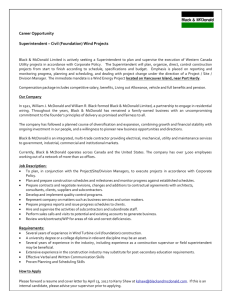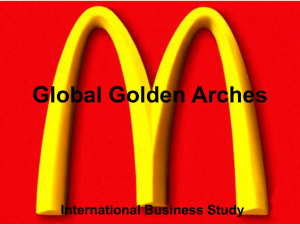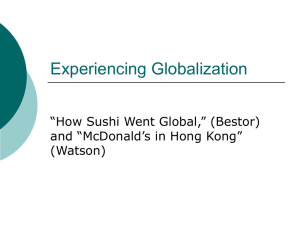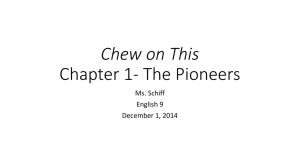Mcvalues - Achieve the Core
advertisement
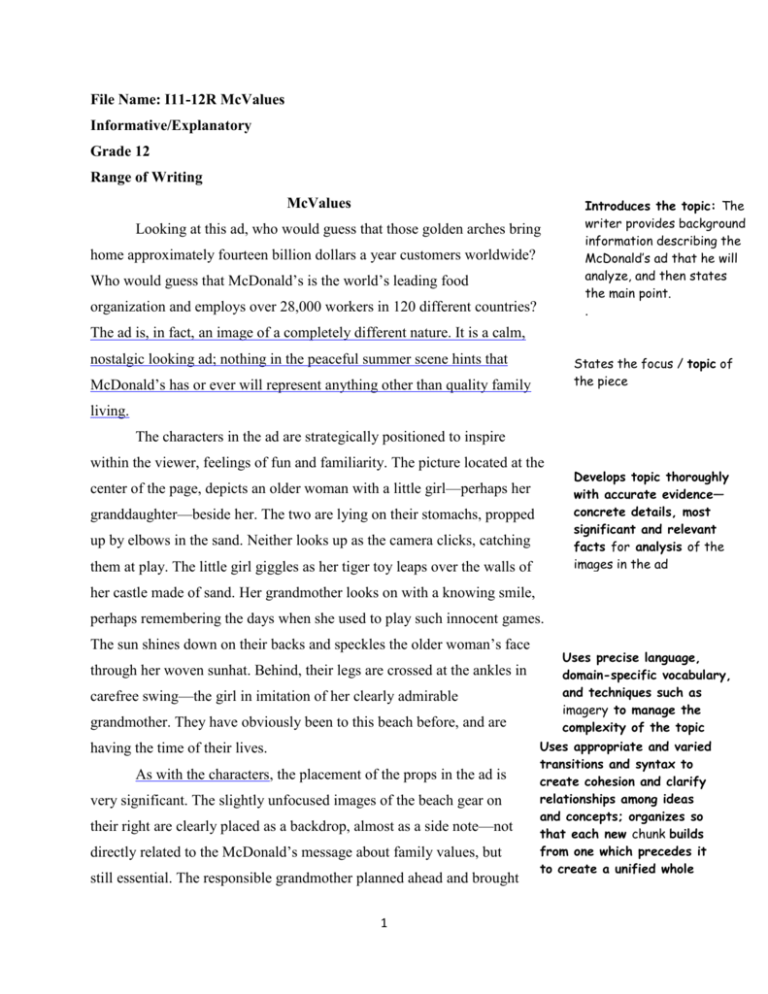
File Name: I11-12R McValues Informative/Explanatory Grade 12 Range of Writing McValues Looking at this ad, who would guess that those golden arches bring home approximately fourteen billion dollars a year customers worldwide? Who would guess that McDonald’s is the world’s leading food organization and employs over 28,000 workers in 120 different countries? Introduces the topic: The writer provides background information describing the McDonald’s ad that he will analyze, and then states the main point. . The ad is, in fact, an image of a completely different nature. It is a calm, nostalgic looking ad; nothing in the peaceful summer scene hints that States the focus / topic of the piece McDonald’s has or ever will represent anything other than quality family living. The characters in the ad are strategically positioned to inspire within the viewer, feelings of fun and familiarity. The picture located at the center of the page, depicts an older woman with a little girl—perhaps her granddaughter—beside her. The two are lying on their stomachs, propped up by elbows in the sand. Neither looks up as the camera clicks, catching them at play. The little girl giggles as her tiger toy leaps over the walls of Develops topic thoroughly with accurate evidence— concrete details, most significant and relevant facts for analysis of the images in the ad her castle made of sand. Her grandmother looks on with a knowing smile, perhaps remembering the days when she used to play such innocent games. The sun shines down on their backs and speckles the older woman’s face through her woven sunhat. Behind, their legs are crossed at the ankles in carefree swing—the girl in imitation of her clearly admirable grandmother. They have obviously been to this beach before, and are having the time of their lives. As with the characters, the placement of the props in the ad is very significant. The slightly unfocused images of the beach gear on their right are clearly placed as a backdrop, almost as a side note—not directly related to the McDonald’s message about family values, but still essential. The responsible grandmother planned ahead and brought 1 Uses precise language, domain-specific vocabulary, and techniques such as imagery to manage the complexity of the topic Uses appropriate and varied transitions and syntax to create cohesion and clarify relationships among ideas and concepts; organizes so that each new chunk builds from one which precedes it to create a unified whole along all they might need for a day on the beach, but does not need to broadcast it to the viewer. In the far corner, an umbrella stands shading their picnic blanket; beside the grandmother’s arm is a pair of sunglasses, and upon her head rests a hat to protect her from the sun. Oh, and what’s that in the corner? Ah yes, the McDonald’s Happy Meal they picked up on their way. Cheeseburgers with french-fries is far from the healthiest picnic Grandma could have brought for her granddaughter, but what does that matter? They’re spending time together. The summer scene in black and white instantly creates a feeling of nostalgia. It is a time warp of sorts, to the safety of the1950s when family Analyzes content of ad for overall effect values were still a part of American society. It jumps back to simpler days when children did as they were told and a day on the beach with family was an acceptable way to spend the weekend—the “good old days” when all was well with the world. The busy parents of today can be assured that McDonald’s is just as wholesome and just as capable of creating memories as their mothers’ picnics were in the 1950s. The first line of print below the picture reads, “Some connections never seem to fade.” The statement refers to the family connection that existed for the parents of today when they were young. The message makes it very clear that the dwindling respect for quality family values is kept alive with McDonald’s. Organizes complex ideas, concepts, and information so that each new element builds on that which precedes it to create a unified whole: The writer draws a connection between the imagery in the ad and the message for today’s parents. In stark contrast to the quiet shades of gray and the general feeling of calm in the photo, the McDonald’s logo stands out sharply in the lower corner. Being the only colored object in the ad, the ketchup and mustard “M” is impossible to miss. There can be no confusion over whose product is being sold. The few sentences about, and the image of, Pooh corner appeals to the whole family—the parents and their Pooh-loving kids. Above the logo and the scene of contentment, the page is blank except for one sentence: “Suddenly the house on Pooh corner doesn’t seem so far away.” This statement, coupled with the image of the girl recreating Pooh’s world on 2 Analyzes content of ad for overall effect the beach, emphasizes the idea that McDonald’s makes dreams come alive. The ad states that Pooh corner doesn’t seem so far away, and right below it is their proof—a little girl playing in “Pooh corner” In the lower right corner, below the hideously-bold, trademark “M”, the ad makes yet another pitch. In this modern world of work and Uses precise language and domain-specific vocabulary, and techniques such as personification to manage the complexity of the topic stress, McDonald’s kindly asks everyone to “smile.” In that one, simple word, so much more is implied. “Slow down, take a break, we’re here to help, be happy, come to McDonald’s, we understand.” Maintains formal style, objective tone The entire ad is an attempt to appeal to the parental ideal. Connecting McDonald’s food with an image of family fun provides an “equal” alternative for busy parents who don’t have room in their lives for quality time with their families. McDonald’s is the world’s largest and fastest growing food chain. It brings in billions of dollars a year, has thousands of stockholders and represents one of the biggest food monopolies in the world, but none of that matters in the ad. Life can be good, and it can be bought at McDonald’s. 3 Provides a concluding section that follows from and supports the information presented: The writer assesses the appeal the ad has for today’s busy parents and then articulates the significance of the topic In this piece of twelfth-grade informative/explanatory writing, the writer addresses the underlying messages of an ad for McDonald’s. She provides some context about McDonald’s and the ad itself in the introduction so that the reader can clearly follow her thinking even without having seen the ad. The writer then indicates that the main analytical purpose of the essay is to unpack the ad’s imagery and to contrast the ad’s implicit messages with the reality of the McDonald’s food empire. The writer organizes the essay clearly and carefully so that each chunk builds upon the one that precedes it. She describes the ad, analyzes its messages, and assesses the appeal of those messages to today’s busy parents. She uses appropriate transitions to clarify relationships among ideas and concepts. Within each chunk, the writer uses precise language and domain-specific vocabulary to describe and analyze the ad. This makes the writer’s thinking and understanding easy to follow. The tone of the essay is objective and the style formal, both appropriate for an essay in cultural criticism. The conclusion follows from and supports the information presented, and reflects on the significance of the topic. File Name: I 11-12R McValues Informative/Explanatory Grade 12 Range of Writing McValues Looking at this ad, who would guess that those golden arches bring home approximately fourteen billion dollars a year customers worldwide? Who would guess that McDonald’s is the world’s leading food organization and employs over 28,000 workers in 120 different countries? The ad is, in fact, an image of a completely different nature. It is a calm, nostalgic looking ad; nothing in the peaceful summer scene hints that McDonald’s has or ever will represent anything other than quality family living. The characters in the ad are strategically positioned to inspire within the viewer, feelings of fun and familiarity. The picture located at the center of the page, depicts an older woman with 4 a little girl—perhaps her granddaughter—beside her. The two are lying on their stomachs, propped up by elbows in the sand. Neither looks up as the camera clicks, catching them at play. The little girl giggles as her tiger toy leaps over the walls of her castle made of sand. Her grandmother looks on with a knowing smile, perhaps remembering the days when she used to play such innocent games. The sun shines down on their backs and speckles the older woman’s face through her woven sunhat. Behind, their legs are crossed at the ankles in carefree swing— the girl in imitation of her clearly admirable grandmother. They have obviously been to this beach before, and are having the time of their lives. As with the characters, the placement of the props in the ad is very significant. The slightly unfocused images of the beach gear on their right are clearly placed as a backdrop, almost as a side note—not directly related to the McDonald’s message about family values, but still essential. The responsible grandmother planned ahead and brought along all they might need for a day on the beach, but does not need to broadcast it to the viewer. In the far corner, an umbrella stands shading their picnic blanket; beside the grandmother’s arm is a pair of sunglasses, and upon her head rests a hat to protect her from the sun. Oh, and what’s that in the corner? Ah yes, the McDonald’s Happy Meal they picked up on their way. Cheeseburgers with french-fries is far from the healthiest picnic Grandma could have brought for her granddaughter, but what does that matter? They’re spending time together. The summer scene in black and white instantly creates a feeling of nostalgia. It is a time warp of sorts, to the safety of the1950s when family values were still a part of American society. It jumps back to simpler days when children did as they were told and a day on the beach with family was an acceptable way to spend the weekend—the “good old days” when all was well with the world. The busy parents of today can be assured that McDonald’s is just as wholesome and just as capable of creating memories as their mothers’ picnics were in the 1950s. The first line of print below the picture reads, “Some connections never seem to fade.” The statement refers to the family connection that existed for the parents of today when they were young. The message makes it very clear that the dwindling respect for quality family values is kept alive with McDonald’s. In stark contrast to the quiet shades of gray and the general feeling of calm in the photo, the McDonald’s logo stands out sharply in the lower corner. Being the only colored object in the 5 ad, the ketchup and mustard “M” is impossible to miss. There can be no confusion over whose product is being sold. The few sentences about, and the image of, Pooh corner appeals to the whole family—the parents and their Pooh-loving kids. Above the logo and the scene of contentment, the page is blank except for one sentence: “Suddenly the house on Pooh corner doesn’t seem so far away.” This statement, coupled with the image of the girl recreating Pooh’s world on the beach, emphasizes the idea that McDonald’s makes dreams come alive. The ad states that Pooh corner doesn’t seem so far away, and right below it is their proof—a little girl playing in “Pooh corner” In the lower right corner, below the hideously-bold, trademark “M”, the ad makes yet another pitch. In this modern world of work and stress, McDonald’s kindly asks everyone to “smile.” In that one, simple word, so much more is implied. “Slow down, take a break, we’re here to help, be happy, come to McDonald’s, we understand.” The entire ad is an attempt to appeal to the parental ideal. Connecting McDonald’s food with an image of family fun provides an “equal” alternative for busy parents who don’t have room in their lives for quality time with their families. McDonald’s is the world’s largest and fastest growing food chain. It brings in billions of dollars a year, has thousands of stockholders and represents one of the biggest food monopolies in the world, but none of that matters in the ad. Life can be good, and it can be bought at McDonald’s. 6


